
views
X
Research source
The hypotenuse is the longest side of the triangle, and it’s also very easy to find using a couple of different methods. This article will teach you how to find the length of the hypotenuse using the Pythagorean theorem when you know the length of the other two sides of the triangle. It will then teach you to recognize the hypotenuse of some special right triangles that often appear on tests. It will finally teach you to find the length of the hypotenuse using the Law of Sines when you only know the length of one side and the measure of one additional angle.
Using the Pythagorean Theorem

Learn the Pythagorean Theorem. The Pythagorean Theorem describes the relationship between the sides of a right triangle. It states that for any right triangle with sides of length a and b, and hypotenuse of length c, a + b = c.
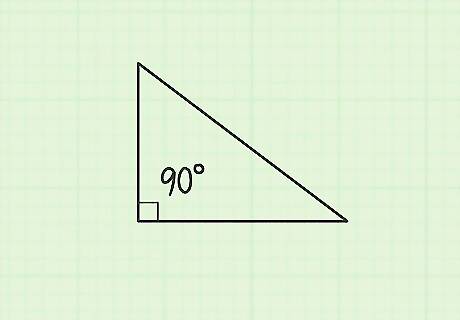
Make sure that your triangle is a right triangle. The Pythagorean Theorem only works on right triangles, and by definition only right triangles can have a hypotenuse. If your triangle contains one angle that is exactly 90 degrees, it is a right triangle and you can proceed. Right angles are often notated in textbooks and on tests with a small square in the corner of the angle. This special mark means "90 degrees."
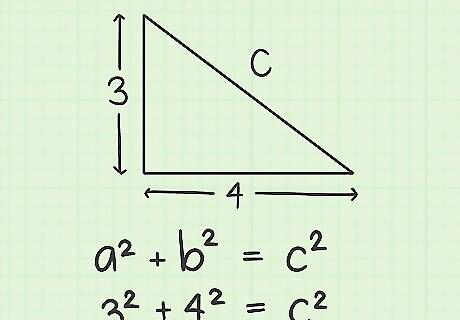
Assign variables a, b, and c to the sides of your triangle. The variable "c" will always be assigned to the hypotenuse, or longest side. Choose one of the other sides to be a, and call the other side b (it doesn't matter which is which; the math will turn out the same). Then copy the lengths of a and b into the formula, according to the following example: If your triangle has sides of 3 and 4, and you have assigned letters to those sides such that a = 3 and b = 4, then you should write your equation out as: 3 + 4 = c.
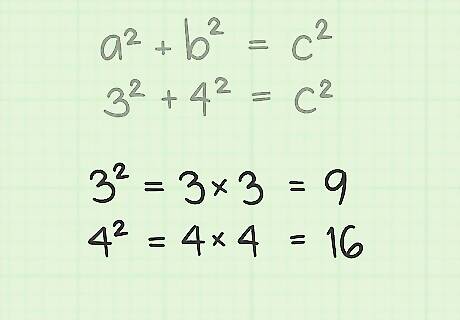
Find the squares of a and b. To find the square of a number, you simply multiply the number by itself, so a = a x a. Find the squares of both a and b, and write them into your formula. If a = 3, a = 3 x 3, or 9. If b = 4, then b = 4 x 4, or 16. When you plug those values into your equation, it should now look like this: 9 + 16 = c.

Add together the values of a and b. Enter this into your equation, and this will give you the value for c. There is only one step left to go, and you will have that hypotenuse solved! In our example, 9 + 16 = 25, so you should write down 25 = c.
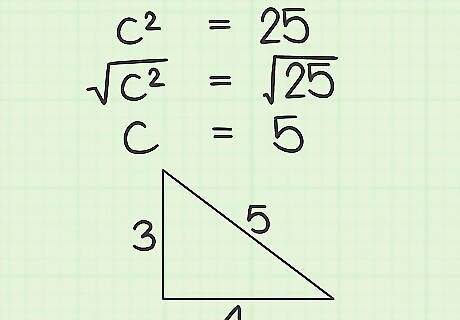
Find the square root of c. Use the square root function on your calculator (or your memory of the multiplication table) to find the square root of c. The answer is the length of your hypotenuse! In our example, c = 25. The square root of 25 is 5 (5 x 5 = 25, so Sqrt(25) = 5). That means c = 5, the length of our hypotenuse! EXPERT TIP Joseph Meyer Joseph Meyer Math Teacher Joseph Meyer is a High School Math Teacher based in Pittsburgh, Pennsylvania. He is an educator at City Charter High School, where he has been teaching for over 7 years. Joseph is also the founder of Sandbox Math, an online learning community dedicated to helping students succeed in Algebra. His site is set apart by its focus on fostering genuine comprehension through step-by-step understanding (instead of just getting the correct final answer), enabling learners to identify and overcome misunderstandings and confidently take on any test they face. He received his MA in Physics from Case Western Reserve University and his BA in Physics from Baldwin Wallace University. Joseph Meyer Joseph Meyer Math Teacher Use this visual trick to understand the Pythagorean Theorem. Imagine a right triangle with squares constructed on each leg and the hypotenuse. by rearranging the smaller squares within the larger square, the areas of the smaller squares (a² and b²) will add up visually to the area of the larger square (c²).
Finding the Hypotenuse of Special Right Triangles

Learn to recognize Pythagorean Triple Triangles. The side lengths of a Pythagorean triple are integers that fit the Pythagorean Theorem. These special triangles appear frequently in geometry text books and on standardized tests like the SAT and the GRE. If you memorize the first 2 Pythagorean triples, in particular, you can save yourself a lot of time on these tests because you can immediately know the hypotenuse of one of these triangles just by looking at the side lengths! The first Pythagorean triple is 3-4-5 (3 + 4 = 5, 9 + 16 = 25). When you see a right triangle with legs of length 3 and 4, you can instantly be certain that the hypotenuse will be 5 without having to do any calculations. The ratio of a Pythagorean triple holds true even when the sides are multiplied by another number. For example a right triangle with legs of length 6 and 8 will have a hypotenuse of 10 (6 + 8 = 10, 36 + 64 = 100). The same holds true for 9-12-15, and even 1.5-2-2.5. Try the math and see for yourself! The second Pythagorean triple that commonly appears on tests is 5-12-13 (5 + 12 = 13, 25 + 144 = 169). Also be on the lookout for multiples like 10-24-26 and 2.5-6-6.5.
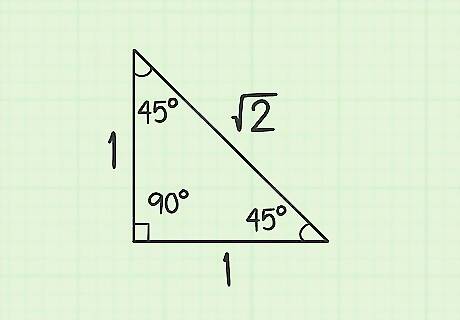
Memorize the side ratios of a 45-45-90 right triangle. A 45-45-90 right triangle has angles of 45, 45, and 90 degrees, and is also called an Isosceles Right Triangle. It occurs frequently on standardized tests, and is a very easy triangle to solve. The ratio between the sides of this triangle is 1:1:Sqrt(2), which means that the length of the legs are equal, and the length of the hypotenuse is simply the leg length multiplied by the square root of two. To calculate the hypotenuse of this triangle based on the length of one of the legs, simply multiply the leg length by Sqrt(2). Knowing this ratio comes in especially handy when your test or homework question gives you the side lengths in terms of variables instead of integers.

Learn the side ratios of a 30-60-90 right triangle. This triangle has angle measurements of 30, 60, and 90 degrees, and occurs when you cut an equilateral triangle in half. The sides of the 30-60-90 right triangle always maintain the ratio 1:Sqrt(3):2, or x:Sqrt(3)x:2x. If you are given the length of one leg of 30-60-90 right triangle and are asked to find the hypotenuse, it is very easy to do: If you are given the length of the shortest leg (opposite the 30-degree angle,) simply multiply the leg length by 2 to find the length of the hypotenuse. For instance, if the length of the shortest leg is 4, you know that the hypotenuse length must be 8. If you are given the length of the longer leg (opposite the 60-degree angle,) multiply that length by 2/Sqrt(3) to find the length of the hypotenuse. For instance, if the length of the longer leg is 4, you know that the hypotenuse length must be 4.62.
Finding the Hypotenuse Using the Law of Sines

Understand what "Sine" means. The terms "sine," "cosine," and "tangent" all refer to various ratios between the angles and/or sides of a right triangle. In a right triangle, the sine of an angle is defined as the length of the side opposite the angle divided by the hypotenuse of the triangle. The abbreviation for sine found in equations and on calculators is sin.

Learn to calculate sine. Even a basic scientific calculator will have a sine function. Look for a key marked sin. To find the sine of angle, you will usually press the sin key and then enter the angle measurement in degrees. On some calculators, however, you must enter the degree measurement first and then the sin key. You will have to experiment with your calculator or check the manual to find out which it is. To find the sine of an 80 degree angle, you will either need to key in sin 80 followed by the equal sign or enter key, or 80 sin. (The answer is -0.9939.) You can also type in "sine calculator" into a web search, and find a number of easy-to-use calculators that will remove any guesswork.
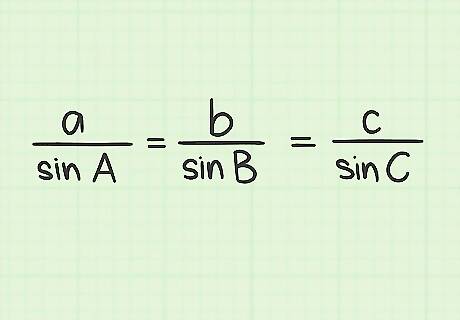
Learn the Law of Sines. The Law of Sines is a useful tool for solving triangles. In particular, it can help you find the hypotenuse of a right triangle if you know the length of one side, and the measure of one other angle in addition to the right angle. For any triangle with sides a, b, and c, and angles A, B, and C, the Law of Sines states that a / sin A = b / sin B = c / sin C. The Law of Sines can actually be used to solve any triangle, but only a right triangle will have a hypotenuse.

Assign the variables a, b, and c to the sides of your triangle. The hypotenuse (longest side) must be "c". For the sake of simplicity, label the side with the known length as "a," and the other "b". Then assign variables A, B, and C to the angles of the triangle. The right angle opposite the hypotenuse will be "C". The angle opposite side "a" is angle "A," and the angle opposite side "b" is "B".
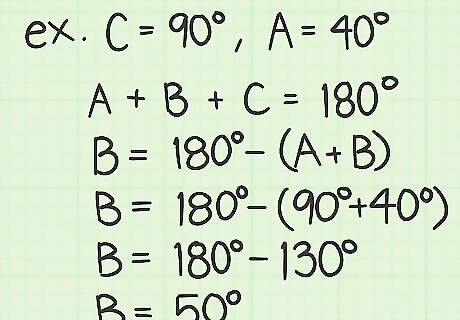
Calculate the measurement of the third angle. Because it is a right angle, you already know that C = 90 degrees, and you also know the measure of A or B. Since the internal degree measurement of a triangle must always equal 180 degrees, you can easily calculate the measurement of the third angle using the following formula: 180 – (90 + A) = B. You can also reverse the equation such that 180 – (90 + B) = A. For example, if you know that A = 40 degrees, then B = 180 – (90 + 40). Simplify this to B = 180 – 130, and you can quickly determine that B = 50 degrees.
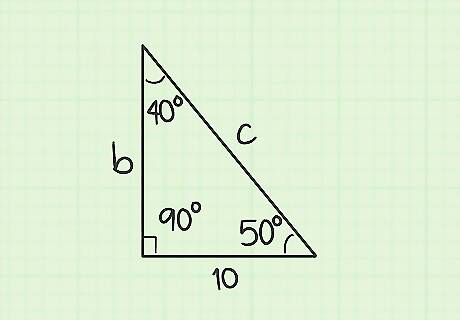
Examine your triangle. At this point, you should know the degree measurements of all three angles, and the length of side a. It is now time to plug this information into the Law of Sines equation to determine the lengths of the other two sides. To continue our example, let's say that the length of side a = 10. Angle C = 90 degrees, angle A = 40 degrees, and angle B = 50 degrees.
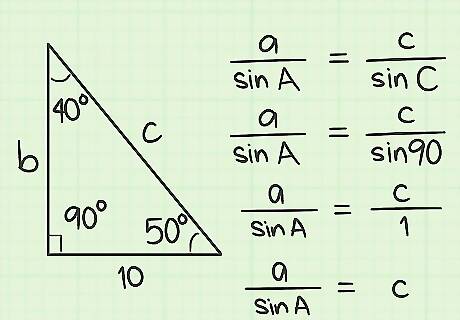
Apply the Law of Sines to your triangle. We just need to plug our numbers in and solve the following equation to determine the length of hypotenuse c: length of side a / sin A = length of side c / sin C. This might still look a bit intimidating, but the sine of 90 degrees is a constant, and always equals 1! Our equation can thus be simplified to: a / sin A = c / 1, or just a / sin A = c.

Divide the length of side a by the sine of angle A to find the length of the hypotenuse! You can do this in two separate steps, by first calculating sin A and writing it down, and then dividing by a. Or you can key it all into the calculator at the same time. If you do, remember to include parentheses after the division sign. For example, key in either 10 / (sin 40) or 10 / (40 sin), depending on your calculator. Using our example, we find that sin 40 = 0.64278761. To find the value of c, we simply divide the length of a by this number, and learn that 10 / 0.64278761 = 15.6, the length of our hypotenuse!
Finding the Hypotenuse Using the Area
Identify the formula to use. There are many variations of the formula for the area of a right triangle. You may already be familiar with the formula Area = 1/2 x base x height. But the known parameters determines which formulas you can work with. You can find the most commonly used formulas for calculating the area of right and non right angles with worked examples in this article. The variation that directly relates the area to the hypotenuse is Area = 1 2 × c 2 × sin α × cos α {\displaystyle {\text{Area}}={\frac {1}{2}}\times c^{2}\times \sin \alpha \times \cos \alpha } {\displaystyle {\text{Area}}={\frac {1}{2}}\times c^{2}\times \sin \alpha \times \cos \alpha } Rearrange formula to make hypotenuse the subject. The variable "c" represents the hypotenuse.Formula_for_hypotenuse_with_area.png
Assign the variables. α {\displaystyle \alpha } \alpha represents an angle on the right angle other than the 90 degree angle. So it is up to you to assign any of the other two angles as α {\displaystyle \alpha } \alpha . The other variable in the formula is the area, which as the name suggests refers to the area of the triangle. For example, in a right angle triangle of angles 90 degrees , 56.5 degrees, 33.5 degrees and an area of 32 cm 2 {\displaystyle {\text{cm}}^{2}} {\displaystyle {\text{cm}}^{2}}, the variables would be α = 56.5 {\displaystyle \alpha =56.5} {\displaystyle \alpha =56.5} degrees OR α = 33.5 {\displaystyle \alpha =33.5} {\displaystyle \alpha =33.5} degrees, and Area = 32 cm 2 {\displaystyle {\text{Area}}=32{\text{cm}}^{2}} {\displaystyle {\text{Area}}=32{\text{cm}}^{2}}Example_triangle_area_and_angles.png
Apply the formula to your triangle. We just need to plug in the variables to the formula and solve the following equation to determine the length of hypotenuse c. c = 2 × Area sin α × cos α {\displaystyle {\text{c}}={\sqrt {\frac {2\times {\text{Area}}}{\sin \alpha \times \cos \alpha }}}} {\displaystyle {\text{c}}={\sqrt {\frac {2\times {\text{Area}}}{\sin \alpha \times \cos \alpha }}}} Substituting the values in our example, we get: c = 2 × 32 sin ( 56.5 ) × cos ( 56.5 ) {\displaystyle {\text{c}}={\sqrt {\frac {2\times 32}{\sin(56.5)\times \cos(56.5)}}}} {\displaystyle {\text{c}}={\sqrt {\frac {2\times 32}{\sin(56.5)\times \cos(56.5)}}}}. Note that you could have chosen 33.5 degrees as α {\displaystyle \alpha } \alpha instead of 56.5.You can find the sin and cosine values using a calculator. After simplifying everything the final answer would be c = 11.8 (rounded to the nearest 1st decimal place). Therefore the length of the hypotenuse of the right triangle in the example is 11.8 cm.




















Comments
0 comment